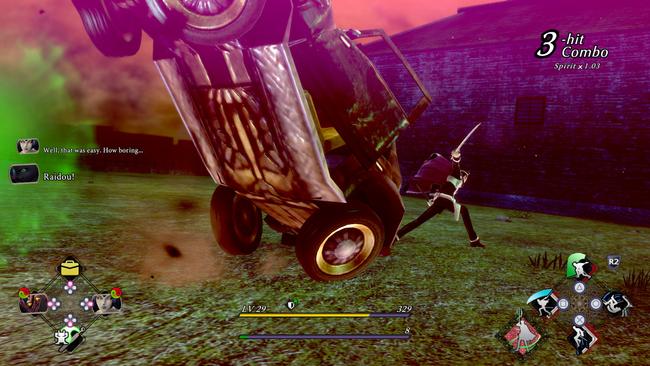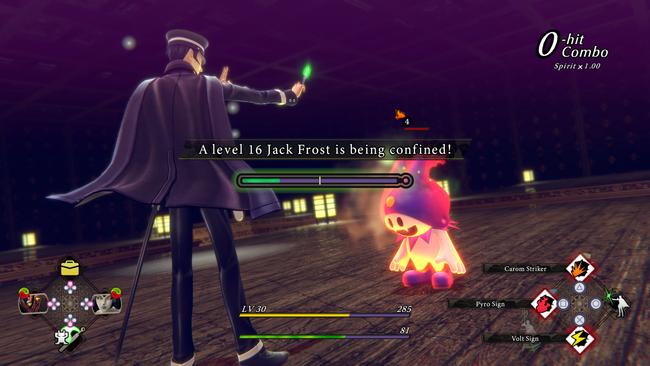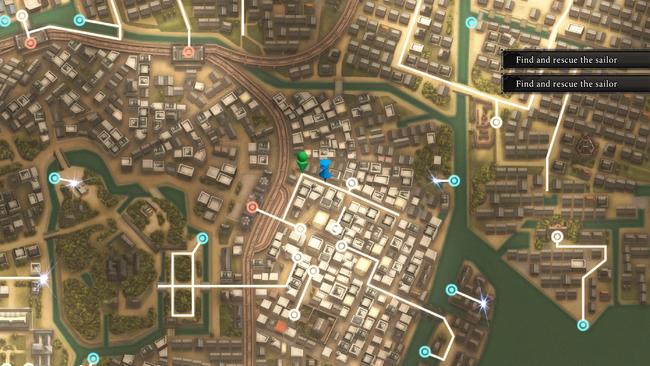
Raidou Remastered: The Mystery of the Soulless Army Review
I have a soft spot for the Devil Summoner series, with the 3DS release of Soul Hackers being one of my first entry points into the larger Megami Tensei franchise. These games all have their share of noticeable flaws, but those flaws are simply part of the appeal to me. I felt this way about the recent Soul Hackers 2, and especially with the original Devil Summoner: Raidou Kuzunoha vs. the Soulless Army. I can’t imagine a more ideal kind of PS2 gem better suited for my tastes. It’s obtuse, clunky, but overflowing with charm. Blending traditional Shin Megami Tensei demon summoning with action combat and adventure game progression is a recipe for an interesting time, at the very least.
Raidou Remastered: The Mystery of the Soulless Army is ironically a full remake of the original PS2 title, featuring redone visuals, voice acting, a new combat system, and a plethora of quality of life improvements. We see modern SMT staples like Reverse and Search fusion, customizable inherit skills, dashing on the field, fast travel, auto saving quicksaves, and much more. There’s a lot of added quality of life here, so much that it feels like an entirely new game.
As a member of the organization Yatagarasu, you play as young Devil Summoner Raidou Kuzunoha XIV in the year Taishō 20. You’re tasked with working with a local detective to keep an eye out on the capital, alongside your talking cat Gouto. Each chapter sees Raidou and Gouto solving some kind of supernatural mystery, while fighting and collecting demons. They’ll jump back and forth between the human and Dark Realm in 1930s Tokyo to solve their cases. You can chat with people on the street, using your demons to influence them to get more information.

Not only are demons helpful allies in combat, but each demon in your arsenal has a unique skill that can activate depending on their Type when summoned. In addition to just being able to work the crowds, demons can be sent off into the field to solve puzzles. You can have them fly, scout for items, check the map for enemies, or be sent off on their own for solo investigations to get things Raidou can’t reach. Solo investigations will have you control the demons, and even let you play a handful of battles with just them. There haven't been many Shin Megami Tensei games with ADV mechanics, and this is a really fun way to utilize demon collection for that genre.
The original PS2 version chose to depict its throwback Tokyo setting almost entirely with pre-rendered backgrounds. Not only did it allow Tokyo to be packed with detail, but they were smart for budget and hardware limitations. A game like Shin Megami Tensei III Nocturne was handled in full 3D, which makes the transfer to HD rather seamless visually. That’s a lot harder to do for games with pre-rendered backgrounds, but I could have never imagined they’d put in the effort of just remake everything from scratch. This endeavor paid off.
Visually, Raidou Remastered is a knockout. Despite everything being remade from the ground up, I can’t help but feel this is exactly what the game looked like in my most nostalgic memories of playing this in college when it dropped on PSN. It obviously has a distinct style, but the effort put into presenting the new graphics from the perspective of the original game is commendable. The lighting and shading on 3D models in this game are frankly perfect, setting a high bar for any future ATLUS revival of a PS2 game. Getting to the bathhouse brawl from Episode 2 just to see they went as far as to mimic the same camera angle got a smile out of me. They’ve gone as far as to remake all of the pre-rendered movies in the new style, and even kept some of the shots in town as pre-rendered images.

New to this version of the game is the removal of random encounters, which were nigh-constant in the original PS2 release, even in the Human realm. This naturally means you’ll be fighting fewer battles, making the experience much more lean. Being able to roam around and talk to people at my leisure is a great change, especially since it makes moments of demon interference in the story stand out more. It’s also great to be able to pay a small fee to use the street cars to travel to another location, in case you want a break to stock up on supplies or go handle some Case Files.
‘Case Files’ are how the development team has organized the original game’s side content. Demons that you’d originally have to go out of your way to find are now marked out on the field and assigned a Case File, making it so you can’t easily miss out on anything as long as you’re looking for it. They’ve even added a handful of new side quest chains, typically around newly added Demons like SMT V’s Hayataro.
By and large, all of the new quality of life improvements feel tasteful and add something to the experience, but I can’t help but feel some level of friction was removed. There are a few smaller additions that may be nothing more than nitpicks in the grand scheme of things, like no longer needing to hit a weak point to capture demons. A larger complaint I have, which I noted in my preview, is the addition of forced objective markers. These should definitely be an option for players who would find the game too obtuse, but a lot of the mystery and problem solving of the original game has been considerably sanded down. These markers are also inconsistently used, with some being far too overbearing and some sections letting you solve puzzles without interjecting. The trade-off for losing the classic feel of adventure game puzzle-solving was replaced with the needs of a polished modern action game.

While it might seem contradictory to dislike mandatory main story objectives but enjoy the game pointing out side content, that’s handled in a much less intrusive manner. It simply points you to where you’d need to go, and you’re left to check the Case File description or ask around from there. You’ll often have to interpret what to do from there, or mentally note a distraction to come visit later. A game with these markers is better than a game for most people than one without, but I think a toggle would have gone a long way. Options go a long way.
Following the highway of objective markers also has an effect on the game’s pacing, as you’ll fly through the main story now. You’ll always know exactly where to go, so the story beats play out fast. It can get a bit overwhelming, especially with the chapters in the back half already being pretty quick. I’ll restate my wish for a toggle for objective markers, since getting a chance to take my time and figure things out for myself would have heightened my enjoyment. Knowing what NPCs are plot-important and which ones can be ignored takes away from the sense that all of these people contribute to the game’s tone and atmosphere. Gotou is already much more willing to provide hints in the dialogue, so having only his words as a reference on making progress would have actually been a great experience if they allowed me to turn these off.
While there’s a part of me that wished for the slower pace of the original to be kept, I have to acknowledge that some of that pace was because of padding. By cutting the constant random encounters and cutting the guesswork, Raidou Remastered shows just how lean the original game actually was. A lot of my time spent working through the original Raidou back in the day was from running into frequent battles, and getting lost just meant more battles. My first playthrough of Raidou Remastered took around 21 hours, and that’s with a majority of Case Files done. It was nice to have a shorter and focused SMT, which is not something I could say as much with the original.

I’ve had a lot more time with Raidou Remastered’s battle system since my preview. I went into excruciating detail in that article, and I stand by what I said about the game feeling being quite nice to play now. The stiff battle system of the original with a single melee attack and an elemental gun attack has been replaced with something a lot closer to the sequel’s. You have a light and a heavy attack now, each with their own combo strings. Light attacks are for building up your MAG meter, which is what your demons need to use their skills. Heavy is better suited for damage dealing, especially when you stun them with a weakness or break a boss’ shield. Both of these will also have Raidou dash towards his targeted enemy, keeping you always right in the middle of action at any moment.
To maintain consistent DPS and healing, it’s important to have Raidou active in keeping up the pressure with light attacks. Ally demons will draw your MAG fast, so you need to play really aggressively to make sure this meter doesn’t deplete. This just makes it more fun to master evasion timing, as a perfect dodge can activate a Devil’s Bane attack which restores a lot of your MAG. A jump button, responsive dodging, and elemental attacks on cooldown go a long way in making Raidou a pretty fun action game in the moment to moment gameplay. You have more agency than you did before, and encounters are rebalanced to keep this in mind. If you aren’t careful you’ll die fast, but play too careful and your demon’s won’t have enough MAG to work with.
From any save point (or by simply heading back to Tsukudo-cho) you can access the Goumaden, where you can fuse demons and upgrade your weapons. Demons can now be fused regardless of their loyalty stat, but you’re incentivized to build loyalty because demons with maxed out loyalty are far more likely to leave behind items. You can take these items and use them to build weapons with the new Sword Alchemy mechanic. The multiple weapon types (Sword, Axe, Spear) have been ported back to the original Raidou with this mechanic, changing how your heavy attack works.

Sword Alchemy is also how you unlock new special skills and passives. You can map up to three of these Sword Skills, and pull them up by pressing the right trigger and using the associated face button. Once you try out each of the three weapon types after Episode 2, that’s your kit for the rest of the game. I never found any combo extender moves, and it felt like I had seen basically all the game had to offer with Raidou’s kit well before I reached the final act. It’s clear that the focus was on rotating your demons regularly, and keeping them stocked up with MAG and applying DPS does keep the game from ever truly getting boring during combat.
By the middle of the game though, I’m sad to say that working my way through regular encounters started to drag. Normal battles don’t really offer up much of a challenge, and you’ll find yourself doing basically the same thing in each fight. Enemies never feel like they get much more aggressive or deadly by the end, and the damage they do land will get healed away by your demons fast. Some enemies fly around often, but the solution to this is always just pulling your gun out and stunning them. Boss battles pick up the slack a lot, but most of the time in battle will be spent fighting normal demons.
This is also where I began to hit a mental wall with upgrading my weapons. I felt like my Raidou plateaued at this point in the game, and combat essentially felt solved. The extra points into my stats from upgrading my weapon was nice, but new Sword Skills at the end of the tree stop feeling useful. Raidou’s own build feels inconsequential by the end game, and you’ll hit the stat caps by the end. Ultimately this game has a very flashy and responsive battle system that doesn’t have much room to grow. Not bad by any means, but not quite reaching its full potential. This would be a much larger issue if the game wasn’t so short, so combat limitations aren’t overly detrimental to the experience.

While I feel that combat flattens out after the half-way point for most normal encounters, the system consistently excels in the cases when it is pushed to its limits. This is an Action RPG, and understanding the RPG mechanics is crucial for these unique encounters. For example, there’s a Case Files quest chain in the Training Hall where you have to fight a series of 100 demon battles, with them attacking you in waves. It’s absolute chaos, but the panic was enjoyable. Taking the normal enemies that barely are a threat on their own, and overwhelming the player is great design for this kind of simple action game.
However boss fights were a highlight, giving me something to look forward to in every chapter. They all hit hard, and have strict patterns you’ll need to master to keep yourself alive as you chip away their health. Many action games don’t really offer me much of a challenge these days, so there was something refreshing about these difficulty spikes popping up so often. They each feel like MMO bosses, leaning on primarily the RPG aspect of the ARPG. They’ll spawn ads to dispatch, attack you with AOEs, and you’ll need to master a specific pattern to succeed. My reaction time was pushed harder than I expected here, with you needing to quickly be able to pull your demons to you with the Safeguarding mechanic to keep them from instantly dying from unblockable attacks. They can feel cheap, and not all of them are winners, but this lopsided balancing is what makes classic SMT so rewarding. I was a bit worried this would follow the ATLUS trend of making their re-releases too easy, but Raidou Remaster has bite when it needs to.
While I wasn’t able to make much of an emotional connection with the plot, I can’t say I was ever bored. This game’s story goes to some truly ridiculous places, and it’s largely the kind of weird I can get behind. The opening setup of a 1930’s Devil Summoning detective seems quaint compared to where things end up by the time you hit credits. An attempt is made to discuss the economic turmoil of the time, but the bombastic events keep things from lingering for too long.

I’ve never finished the original sequel Raidou Kuzunoha vs. King Abaddon, but I can only imagine all it’s able to accomplish without needing to dedicate so much of the runtime to establishing the setting and characters introduced in this entry. Knowing that the sequel has multiple endings for different choices made in the story excites me as well, as the original Raidou (and this remake) has a linear story. I’ll probably go boot the game up from the start shortly after this is published, which shouldn’t be too much of a challenge with how much shared DNA this remake has with it.
In terms of new story content in Raidou Remastered, they’ve kept things close to the events of the original. New lines of dialogue have been added to clarify confusing plot points or just expand on ideas from the original. I found these additions to enhance my enjoyment of the story, especially in the last chapter where new lines really deliver the game’s main points home. The actual key plot beats all play out the same, but the added flavor text was endearing.
Despite my qualms with the game, I can’t state enough just how impressive of a remake Raidou Remastered is. The amount of effort put into keeping it faithful, yet modernizing it enough to make a fresh experience is commendable. While I would love more ports of their classic catalogue, this latest experiment in ATLUS revitalizing their catalog is a success. Seeing Raidou 2 or the Digital Devil Saga duology in this style would be incredible, but what I truly want to see are these mechanics get another spin without being held back. This is a rock solid base to build off for a possible third Raidou game. The assets for Tokyo are all made, and the combat system is just begging to be iterated on further with brand new encounter design.
Raidou Remastered has undoubtedly improved a flawed game, but there’s only so much it could do in keeping to its mission statement to recreate the content of the original title. I respect the lengths Atlus went to provide a largely faithful, yet polished, version of Raidou's debut. It's a fascinating way to revisit that era of games, and in a way, I’m glad Atlus didn’t simpy outright scrap tedious aspects of the original. Raidou Kuzunoha is a tried and true Devil Summoner entry in every way, and I’m glad ATLUS is still willing to revisit this scrappy series.